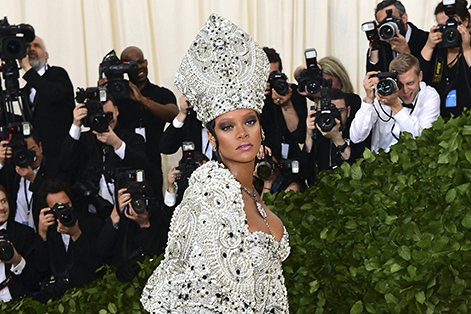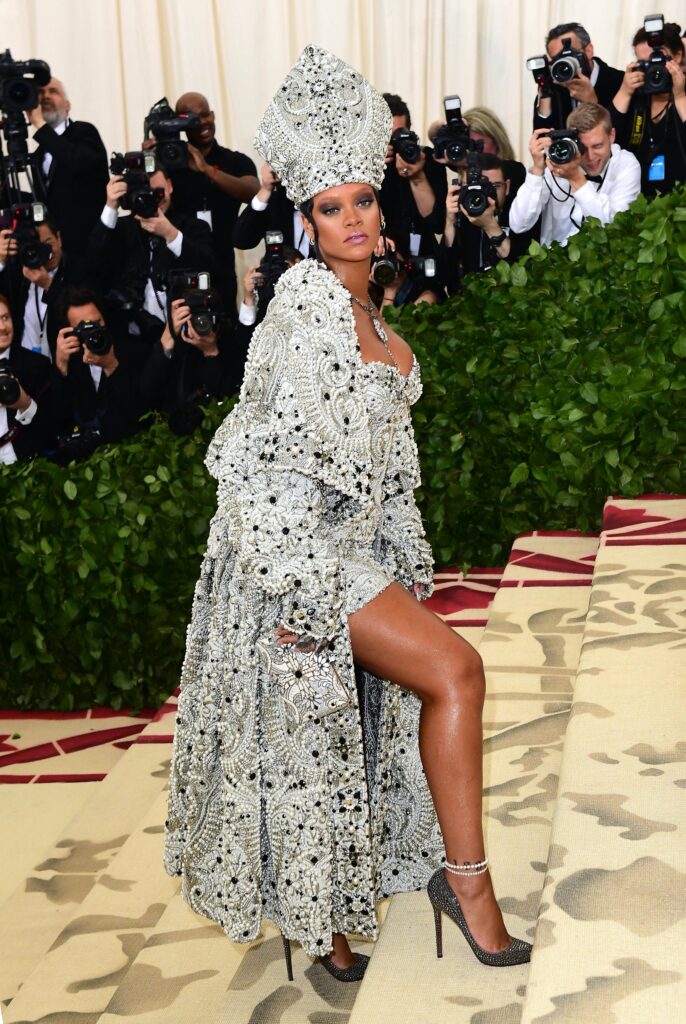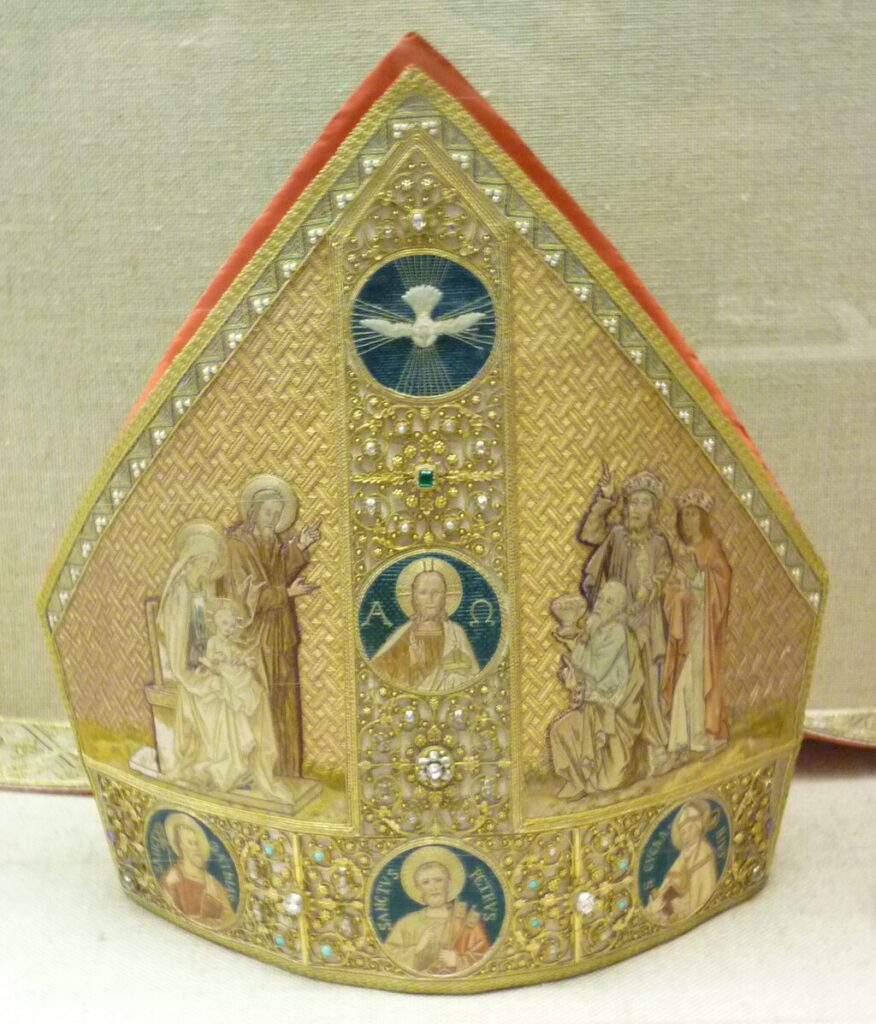2018 Rihanna’s Papal Look at the Met Gala

Religion: Christianity
Time Period: 2010s
Type Of Garment: Dress, Headpiece, Robe
Tags: Catholicism, Cross, France, High Fashion, John Galliano, Maison Margiela, Met Gala 2018, Rihanna, United States
The Context:

The Met Gala, a fundraising event that benefits the Metropolitan Museum of Art’s Costume Institute in New York City, marks the grand opening of the Costume Institute’s annual fashion exhibit. It is arguably one of the most exclusive and anticipated fashion events of the year. According to Anna Wintour, Vogue editor and Chair of the event since 1995, the Gala has “become one of the rare occasions when movie stars, models, designers, society swans, rock legends, athletes, politicians, and rappers, not to mention a cultural icon or two, come together to celebrate fashion—and get to spend a night at the museum” (Waxman 2024). The Gala’s annual theme highlights the Costume Institute’s exhibit and inspires the bold, theatrical looks worn by celebrities. In 2018, fashion and religion dominated the red carpet as famous attendees embraced the year’s theme: “Heavenly Bodies: Fashion and the Catholic Imagination.” Singer, actress, businesswoman, and fashion icon, Rihanna served as one of the Gala’s co-chairs and took center stage with her papal-inspired look. As one fashion journalist stated, “Rihanna Won the Met Gala–and Took the Fashion Crowd to Church” (Okwodu 2018; see Figure 1).
The Object and Creator:

Rihanna’s look consisted of a fitted corset dress, a detachable train, an overcoat, and a mitre, all heavily embellished with pearls and crystals. With its long train, structured shoulders, and a silhouette that evoked papal robes as much as monarchy, the outfit seemed fitting for this most exclusive fashion event. Designed by John Galliano, creative director at Maison Margiela since 2014, the look blended avant-garde elements with traditional papal vestments, respectfully reimagining Catholic iconography while adding his signature daring artistic twist. “The design took a whopping 250 hours to sew and 500 hours to hand-embroider at the Maison Margiela Atelier in Paris” (Brown 2018). Galliano’s use of lavish materials and rich trims emphasized the grandeur typically associated with ecclesiastical attire, but took this sartorial trend to a couture level.
And in thinking about religion and fashion, the mitre took the look to a spiritual level. Without it, the ensemble reads beautiful and regal, but not necessarily Christian or papal. While not borrowed from Cardinal Dolan (a rumor that circulated online), the miter was the star of the show. It featured a bejeweled cross and represented an unmistakable nod to the ceremonial headpiece traditionally worn by Catholic cardinals, bishops, and popes for liturgical events. It is symbolic of their spiritual authority and standing as leaders of the Catholic Church (Hume 2010).
During the early history of Christianity, the dress of church leaders, including the pope, was simple and similar to that of ordinary people, specifically a robe or tunic made of gray or white wool or linen (History World). However, as Christianity gained widespread acceptance, papal attire became increasingly elaborate and embellished. Scholar Lynne Hume writes, “At the height of the Church’s power around the year 1054, when the Roman Catholic Church split from the Orthodox Church of the Byzantine Empire, the pope in Rome was viewed by the people as God’s representative on earth and dressed in splendid robes and jewels, wearing a type of crown [a mitre] as a symbol of his power, articulating his equal status with royalty” (2013). By the thirteenth century, mitres made of silk featuring embroidery and precious gems became the norm (Tribe 2023; see Figure 2). Papal dress symbolized spiritual authority and did so in part through luxurious textile vocabularies (The Met).

The Wearer:
Rihanna, the iconic singer and founder of beauty and fashion lines, is known for challenging societal norms and making fashion statements. As one reporter proclaimed, “Rihanna’s status as a fashion icon may be the one that best encapsulates the power and reach of her cultural influence” (Lang 2023). Religion has figured in some of these sartorial proclamations. While Rihanna has not publicly identified as deeply religious, she has expressed a belief in God and a spiritual side (Relevant Magazine). Raised in Barbados, she grew up attending church and religious symbols (Christian and otherwise) have appeared in her work and in her fashion. Prior to the 2018 Papal Look, Rihanna wore a sheer gown made of black lace with silver pendant cross necklaces at the 2014 iHeartRadio Music Awards. The look juxtaposed sexuality and spirituality. Since 2018, religion has continued to be a part of Rihanna’s repertoire. In 2020, her brand had to apologize for using CouCou Chloe’s song “Doom” for her Savage x Fenty lingerie show. Unbeknownst to both the Fenty brand and the artist, the song contained words from a sacred Islamic text, Hadiths, for which both swiftly apologized (Elasser 2020). In 2021, Rihanna wore a pendant of the Hindu deity Ganesha, which resulted in charges of cultural appropriation, and a few years later, in 2024, Rihanna’s nunsploitation parody on the cover of Interview magazine sparked some controversy (Greenough 2024).
Rihanna uses religious imagery as a statement on race and identity. Papal garments in Western culture have historically been used to show authority and create exclusion. As a Black woman in a predominantly white industry, her decision to wear the papal-inspired look can be seen as an act of reclaiming and redefining these symbols of power from her own perspective. Rihanna’s fashion choices are often deliberate, provocative, and designed to spark conversation–even when controversial. Whether challenging societal norms or engaging in artistic expression, she seeks to challenge the patriarchy and the hierarchical structures that these symbols traditionally represent. Rihanna states, “I think women want freedom. They want to be empowered. They want hope. They want love; they want all the things that I want, and I’m not afraid to say those things and act on them, and I think that’s why they identify with me” (Byrd). In her 2018 Met Gala look Rihanna’s papal outfit embodied that empowerment and challenged the Catholic Church’s claims to authority, especially its authority over women and their bodies.
Salima Zeira, Politics & International Affairs and Religious Studies Majors, WFU 2027.
October 15, 2024
Tags: Catholicism, Cross, France, High Fashion, John Galliano, Maison Margiela, Met Gala 2018, Rihanna, United States
References:
Brown, Indya. 2018. “See Rihanna’s Pope Met Gala Outfit before It Came to Life.” The Cut, May 8, 2018. Available at: thecut.com/2018/05/rihanna-met-gala-2018-pope-outfit.html.
Byrd, Kiara. n.d. “11 Rihanna Quotes That Manifested Her Boss Empire.” REVOLT. Accessed November 30, 2023. Available at: revolt.tv/article/2023-11-30/344229/11-rihanna-quotes-that-manifested-her-empire.
Greenough, Chris. 2024. “Rihanna’s Religious Imagery Is a Protest against Feminine Ideals of Respectability and Decency.” The Conversation, April 16, 2024. Available at: theconversation.com/rihannas-religious-imagery-is-a-protest-against-feminine-ideals-of-respectability-and-decency-227733.
History World. n.d. “The Papacy: 1st – 8th Century.” HistoryWorld. Accessed October 3, 2024. Available at: https://www.historyworld.net/history/Papacy/543?section=1st8thCentury.
Hume, Lynne. 2010. “Dress and Religious Practices.” In Berg Encyclopedia of World Dress and Fashion: Global Perspectives, edited by Joanne B. Eicher and Phyllis G. Tortora, 77–84. Oxford: Berg. Accessed October 30, 2024. http://dx.doi.org/10.2752/BEWDF/EDch10010.
Hume, Lynne. 2013. “Hierarchies and Power: Christianity and the Roman Catholic Church.” In The Religious Life of Dress: Global Fashion and Faith, 13–34. Dress, Body, Culture. London: Bloomsbury Academic. Accessed October 30, 2024. http://dx.doi.org/10.5040/9781474290326/RELDRELH0004.
Lang, Cady. 2023. “Rihanna’s 25 Best Fashion Moments of All Time.” Time.com, 7 February 2023. Available at: time.com/6251429/rihanna-fashion-best-moments/.
Okwodu, Janelle. 2018. “Rihanna Won the Met Gala—and Took the Fashion Crowd to Church.” Vogue.com, May 8, 2018. Available at: vogue.com/article/rihanna-met-gala-red-carpet-dress-celebrity-style.
Relevant Staff. 2023. “Five Times Rihanna Opened Up About Her Faith.” Relevant Magazine, 14 February 2023. Available at: relevantmagazine.com/culture/five-times-rihanna-opened-up-about-her-faith
Tribe, Shawn. 2023. “The History and Development of the Mitre.” Liturgical Arts Journal, 16 January 2023. Available at: liturgicalartsjournal.com/2022/09/the-history-and-development-of-mitre.html.
Waxman, Olivia B. 2024. “The History behind the Met Gala.” Time, 1 May 2024. Available at: time.com/6972918/met-gala-history/.
